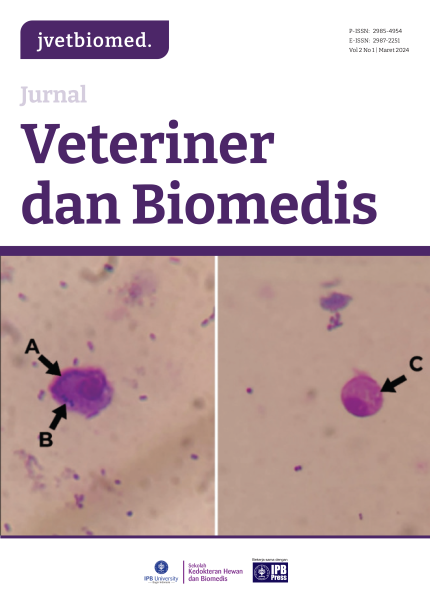Sitotoksisitas Ekstrak Cabe Merah Keriting (Capsicum annum) Terhadap Hela Cell Lines
Abstract
Kanker merupakan suatu penyakit sel yang ditandai dengan hilangnya fungsi kontrol sel terhadap regulasi daur sel maupun fungsi homeostatis sel pada organisme multiseluler. Penelitian ini bertujuan untuk menganalisis efek sitotoksik dan nilai IC50 dari esktrak Capsium annuum pada cell line HeLa sebagai salah satu sel uji untuk kanker serviks. Uji aktivitas sitotoksik ekstrak Capsicum annuum dilakukan dengan memberikan 5 seri konsentrasi bahan uji yaitu 50 μg/ml, 100 μg/ml, 200 μg/ml, dan 400 μg/ml pada HeLa cell lines yang kemudian diinkubasikan selama 24 jam. Penghitungan sel dilakukan setelah pemberian MTT dan SDS stopper. Persentase inhibisi yang dihasilkan dari masing-masing konsentrasi sampel uji secara berturut-turut adalah 17,98%, 23,88%, 32,64%, dan 45,62%. Ekstrak Capsicum annuum mempunyai nilai IC50 sebesar 1,098 μg/mL. Berdasarkan data dari National Cancer Institute nilai IC50 dari Capsicum annuum terhadap HeLa cell lines termasuk dalam kategori sitotoksisitas lemah. Sehingga dapat disimpulkan ekstrak Capsicum annuum tidak bersifat sitotoksik terhadap HeLa cell lines.
References
Al-Samydai A, Khalilbustanji Y, Azzam H, Al-Mamoori F, Al-Tawalbe DM, Abu-Irmaileh B, Aburjai T. 2021. Promising cytotoxicity and anticancer activity of Capsicum annum. Indian Journal of Forensic Medicine & Toxicology, 15(3):1766-1775.
Ali AB, Razali NH, Suk Xian N, Yong Sung C. 2021. The use of herbal therapy to improve the quality of life among cancer patients in the Southern Region of Peninsular Malaysia. Asian Pacific Journal Cancer Prevention, 22(6): 1857-1863. DOI: 10.31557/APJCP.2021.22.6.1857.
Bhalabhai JG, Rajhans S, Pandya H, Mankad A. 2021. A comprehensive review on Capsicum spp. International Journal of Research and Analytical Reviews, 8(4):581-599.
Chapa-Oliver AM, Mejía-Teniente L. 2016. Capsaicin: From Plants to a Cancer-Suppressing Agent. Molecules, 21(8):931. DOI: 10.3390/molecules21080931.
Chilczuk B, Marciniak B, Stochmal A, Pecio L, Kontek R, Jackowska I, Materska M. 2020. Anticancer potential and capsianosides identification in lipophilic fraction of sweet pepper (Capsicum annum). Molecules, 25(13):3097. DOI: 10.3390/molecules25133097.
Fadholly A, Sudjarwo SA, Rantam FA, Mustika AA, Andriyanto, Pristihadi DN, Sutardi LN. 2023. Uji toksisitas cabai merah keriting (Capsicum annuum) pada sel WiDr secara in vitro. Current Biomedicine, 1(2): 70-75. DOI: 10.29244/currbiomed.1.2.70-75
Fadholly A, Ansori ANM, Jayanti S, Proboningrat A, Kusala MKJ, Putri N, Rantam FA, Sudjarwo SA. 2019. Cytotoxic of Allium cepa L. on human colon cancer (WiDr) cells: in vitro study. Research Journal of Pharmacy and Technology, 12(7): 3483-3486. DOI: 10.5958/0974-360X.2019.00591.2
Fathima SN. 2015. A systematic review on phytochemistry and pharmacological activities of Capsicum annum. International Journal of Pharmacy & Pharmaceutical Research, 4(3):51-68.
Gong X, Smith JR, Swanson HM, Rubin LP.2018. Carotenoid lutein selectively inhibit breast cancer cell growth and potentiates the effect of chemotherapeutic agents through ROS-mediated mechanisms. Molecules, 23(4):905.
Habli Z, Toumieh G, Faffat M, Rahal ON, Gali-Muhtasib H. 2017. Emerging cytotoxic alkaloids in the battle against cancer: overview of molecular mechanism. Molecules, 22(2):250.
Juhariah J, Aulia MP. 2021. Analisis Tanaman cabai keriting dalam polybag menggunakan pupuk fermentasi urin sapi. Metana: Media Komunikasi Rekayasa Proses dan Teknologi Tepat Guna, 17(2):49-54.
Kementerian Kesehatan RI. 2022. Buku Pelaksanaan Hari Kanker Sedunia: situasi penyakit kanker. Jakarta.
Kurnijasanti R, Fadholly A. 2021. Cytotoxic effect of Capsicum annum L. extract on T47D cells: in vitro study. Research Journal of Pharmacy and Technology, 14(6):3389-2. DOI: 10.52711/0974-360X.2021.00589
Maji AK, Benerji P. 2016. Phytochemistry and gastrointestinal benefits of the medicine spice, Capsicum annum L. (Chili): a review. J. Complement Integr. Med. 13(2):97-122.
Sung H, Ferlay J, Siegel RL, Laversanne M, Soerjomataram I, Jemal A, Bray F. 2020. Global Cancer Statistics 2020: GLOBOCAN Estimates of Incidence and Mortality Worldwide for 36 Cancers in 185 Countries. CA: Cancer Journal for Clinicians, 71(3): 209-249. DOI: 10.3322/caac.21660.
Zuñiga Martinez ML, López Mendoza CM, Tenorio Salazar J, García Carrancá AM, Cerbón Cervantes MA, Alcántara-Quintana LE. 2022. Establishment, authenticity, and characterization of cervical cancer cell lines. Molecular and Cellular Oncology, 9(1):2078628. DOI: 10.1080/23723556.2022.2078628.
Copyright (c) 2024 Amaq Fadholly

This work is licensed under a Creative Commons Attribution 4.0 International License.







